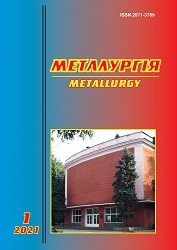PREDICTION OF METAL TEMPERATURE IN PRODUCTION ALUMINIUM WIRE ROD
Abstract
A method is proposed for calculating the temperature schedule in the technological line of a casting and rolling unit (LPA) for the production of aluminum wire rod. The technique was created on the basis of an analysis of literary sources devoted to the mathematical modeling of similar processes. Temperature prediction is carried out using formulas and equations existing in the literature, which are used to calculate: the change in the temperature of the ingot in the process of cooling the mold with water; air cooling of the billet on the way from the mold to the rolling mill and wire rod when laying it in a coil; change in strip temperature during hot rolling; decrease in the temperature of the strip during forced cooling by emulsion in the rolling mill and wire rod in the quenching device. The error in predicting the temperature of the billet at t Ніколаєнкоhe exit from the casting wheel is 1.7%, and in front of the rolling mill 0.8%. The calculated temperature of the wire rod at the exit from the rolling mill differs from the actual one by 3%, and after the quenching device the discrepancy is 1.3%. The simulated wire rod temperature at the end of the production line almost coincides with the actual one. The presence of a mathematical model of the thermogram of an aluminum ingot makes it possible to study the effect of various heat losses occurring during metal crystallization on the temperature of the workpiece after the casting wheel, see and understand the nature of the change in the temperature of the strip from the first to the last stand of the rolling mill, calculate the temperature of the wire rod after its cooling in the quenching device. All this makes it possible to reasonably correct the technology in individual sections of the casting and rolling unit and improve the control algorithms for technological parameters and mechanisms.
References
2. Rosenber Yu.A., Shokhirev N.V., Korkushko V.S. On the singular expansion method pplied to the analysis of a diffiractiol ineshape. Thirteenth Internatinal Congress. Internat in aluminium of crystallography.18 August, 1984. «Acta. Crystallography», Hamburg, 1984. A 40, S 4, С 435.
3. Хэтч Дж. Е. Алюминий: свойства и физическое металловедение : справ. изд-е ; пер. с англ. Москва : Металлургия, 1989. 422 с.
4. Клейменова Ю.Ю., Ерхина В.Ф. Исследование структуры и свойств катанки из алюминиевого сплава АВЕ, полученной совмещенными методами. Сибирский федеральный университет. Красноярск, 2016. С. 91–94.
5. Ніколаєнко, А.М., Трегулова І.П., Баришенко О.М. Дослідження теплообміну у роторній ливарній машині. Металургія : наукові праці Запорізької державної інженерної академії. Запоріжжя : РВВ ЗДІА, 2017. Вип. 1(41). С. 64–69.
6. Черняк С.Н., Коваленко П.А., Симонов В.Н. Бесслитковая прокатка алюминиевой ленты. Москва : Металлургия, 1976. 136 с.
7. Телегин А.С., Гордон Я.М., Зобнин Б.Ф., Казяев М.Д. Теплотехнические расчеты металлургических печей. Москва : Металлургия, 1993. 368 с.
8. Михеев М.А., Михеева И.М. Основы теплопередачи. Москва : Энергия, 1977. 344 с.
9. Юдаев Б.Н. Теплопередача. Москва : Высшая школа, 1981. 319 с.
10. Никитенко Н.И. Теория тепломассопереноса. Киев : Наукова думка, 1983. 352 с.
11. Шилов В.А., Пономарев А.А., Николаев М.С. Моделирование температурных режимов прокатки на новом мелкосортно-проволочном стане. Труды международной научно-технической конференции «Современные металлические материалы и технологи» (СММТ-2011). 21-24.06.2011. СПб : Изд-во Сан-Петербургского политехнического университета, 2011. С. 70–71.
12. Никитин Г.С., Восканьянц А.А., Крюков К.А. Расчет энергосиловых параметров при горячей прокатке в непрерывной группе сортового стана: метод. указания. Москва : Изд-во МГТУ им. Н. Э. Баумана, 2010. 28 с.
13. Сидельников С.Б. Константинов И.Л., Ворошилов Д.С. Технология прокатки : учебник. 3-е изд., доп. и перераб. Красноярск : Сибирский федеральній университет, 2016. 180 с.
14. Загиров Н.Н., Константинов И.Л., Иванов Е.В. Основы расчетов процессов получения длинномерных металлоизделий методами обработки металлов давленим : учеб. пособие. Красноярск : Сибирский федеральный университет, 2011. 312 с.
15. Остапенко А.Л., Курдюкова Л.А. Сопротивление деформации алюминия, меди и их сплавов. Производство проката. 2011. № 1. С. 10–24.
16. Яловой Н.И., Тылкин М.А., Полухин П.И., Васильев Д.И. Тепловые процессы при обработке металлов давленим. Москва : Высшая школа, 1973. 631 с.
17. Жучков С.М., Кулаков Л.В., Лохматов А.П. Исследование влияния технологических факторов на температурный режим прокатки на непрерывном мелкосортном стане. Фундаментальные и прикладные проблемы черной металлургии : сб. науч. тр. ИЧМ. Киев : Наукова думка. 2001. Вып. 4. С. 121–127.
18. Генкин А.Л., Куделин Р.А., Шаталов Р.Л. Алгоритм и система управления показателями качества полосы при горячей прокатке с межклетевым охлаждением раската. Производство проката. 2007. № 9. С. 30–36.

 ISSN
ISSN 


